 |
|
|
| OR |
|
|

|
|
|
|
|
|
|
|
|
|
|
|
|
|
|
|
|
|
|
|
|
|
|
|
|
|
|
|
|
|
|
|
|
|
|
|
|
|
|
|
|
|
|
|
Frithjof Schuon’s life and work
|
|
This site includes Frithjof Schuon’s biography, photos, online articles, slideshows, bibliography, links, and more.
|
|
|
|
|
|
|
Frithjof Schuon (1907-1998) is best known as the foremost spokesman of the “Traditionalist” or “Perennialist” school and as a philosopher in the metaphysical current of Shankara and Plato. He has written more than two dozen books on metaphysical, spiritual, artistic, and ethnic themes and was a regular contributor to journals on comparative religion in both Europe and America. Schuon’s writings have been consistently featured and reviewed in a wide range of scholarly and philosophical publications around the world, respected by both scholars and spiritual authorities.
Frithjof Schuon was born in Basle, Switzerland, on June 18, 1907. His father, a great concert violinist and teacher at the Basle Conservatory of Music, was a native of southern Germany, while his mother came from an Alsatian family. Until the age of thirteen Schuon lived in Basle and attended school there, but the untimely death of his father obliged his mother, for economic reasons, to return with her two young sons to her family in Mulhouse, France; and thus it was that Schuon received a French‑language education in addition to his German one. At sixteen, Schuon left school to become self‑supporting as a textile designer—a type of work which made only the most modest demands upon the remarkable artistic talent that he had as yet been given little opportunity to develop. As a child he had already taken much pleasure in drawing and painting, but he never received any formal training in the arts.
Also, from early on, he developed those reading interests that were to make of him a man of formidable learning and a self-taught scholar, readings that for the growing young man spanned metaphysical and mystical material from sacred scriptures such as the Bhagavad Gita and the Psalms, but also the writings of authors such as Goethe, Schiller, and Emerson, and later and most importantly that of the French metaphysician, René Guénon who was a forerunner for Schuon’s resurrection of the religio perennis. The universe of the Upanishads and of the Vedas determined the young man’s innermost vocation as a Vedantist, namely someone who saw Reality in terms of pure divine metaphysics—first the distinction between Reality and illusion, then total conformity of the soul to the Real—while the Psalms provided the human complement as it were to the transpersonal vistas of the Vedanta in that they nurtured his innate sense of prayer and trust in the Lord in which, already as a child walking along the Rhine to school he would converse directly with God, sharing everything with Him as spontaneously and naturally as a child with his father; this became a lifelong habit of personal intimacy with God at all hours.
It is also this aspect of personal prayer that provided the antidote, so to speak, to the risk of metaphysical knowledge remaining just mental knowledge instead of realizational knowledge or the salvific impetus it should be in the consciousness of the sincere believer. Schuon had ample opportunity to comment on the schism in the Western mentality that allowed the mind to operate with virtuoso intelligence but without integral moral commitment to the conclusions truth entails, conclusions that owing to the divine nature of truth have to be ethical and not merely intellectual. The absurdity of this disparity in the Western mentality is something that he found particularly dismaying, for truth and sanctity were, from Schuon’s earliest youth, the twin poles of his nature and later the essential message of his writings and art. From the beginning, Schuon’s knowledge was that of someone who knew and saw from “the inside”; he drew his knowledge from his own ontological well. And one of his life’s purposes was to restore in man that capacity which is innate to men of the Golden Age.
Another key dimension of Schuon’s upbringing was the singular fascination for American Indians. As a boy, Schuon had heard much about the Indians from his paternal grandmother, who as a young girl had spent some time in Washington D.C. There she had become personally acquainted with a Sioux member of a delegation of chiefs to the nation’s capital, and although she was not allowed to accept his offer of marriage, she never forgot her Indian friend or his people and later transmitted her love and admiration for the Indians to her children and grandchildren.
For the young Schuon, who yearned intuitively for a Golden Age in which man was born the predestined vessel of the Divine Image and was hence both prophet and prince, as befits the idea of the imago Dei, the encounter with the model embodied by American Indians awakened as an echo the recognition of the archetypal model of man, that is to say of man as pontifex or as the holy bridge between Heaven and earth with primordial nature as his sacred setting. Late as the American Plains Indians world was, it nonetheless transmitted the spectacular nobility of a long bygone age in which each man could be a warrior-priest in direct communion with the Divine—the “warrior” counterpart serving as a uniquely virile and inspiring model for the manner in which one is to overcome both one’s own soul and the world, in its theofugal tendency that is. A host of drawings by the growing boy of American Indians and portraits of their faces, modeled essentially on his own acute inward notion of integral man rather than on individual human models, attest to the extraordinary veracity of his recognition, which was no less than a Platonic anamnesis in which one is allowed to say that “like meets like”.
As Schuon himself later said, visual assimilation, in his case, came before conceptual assimilation. This ability to see the sacred, to recognize the manifold variety of its manifestations, led him to his discovery of the great religious civilizations of the world, encounters that began partly in museums where he would spend hours assimilating the messages of various traditional worlds. Schuon’s exceptional inductive faculty allied to a powerful imagination[1] enabled him to reconstitute, according to the logic of ontology, what a whole cultural universe was on the basis of just a few telling samples of that culture.
At the precocious age of twelve, he discovered the statues of Buddhas whose depiction of impassive bliss and radiant silence both informed and finally mirrored his own spiritual becoming—sacred harbingers of his own immortal essence. The profundity of those sacred “meetings” were a homecoming for the young Schuon—spiritually orphaned as he was in a secular civilization that was bulldozing millennial centuries of tradition into rubble—who found a mystical confraternity with celestial beings; and yet, these meetings served also as a poignant reminder of the loneliness of his future destiny as a guide of souls (psychopompos), for who is it among men who can understand the nature of a pneumatic, someone who is heaven born? Let alone a man whose whole nature was medieval? In a sense, Schuon was born ancient.
His journey from craft designer, first in Mulhouse then in Paris, to full-fledged spiritual authority took him through many a tribulation, including obligatory enlistment in the French army where he learned to admire the erect discipline of soldiering that mirrored his own invincible self-domination, and then to Marseille; there, a chance meeting with Yemeni dervishes opened the door for a journey to North Africa where, in the Algerian port town of Mostaghanem he met the revered saint, the Shaykh Ahmad al-Alawi, a providential encounter that proved to be the turning point in Schuon’s life because there he received the venerable Shaykh’s blessing, his barakah, both for a spiritual method to undertake the “great journey” as well as the formal—and supraformal—means to guide disciples in his own right. The discovery of North African Islam and of the Maghrebi culture in particular, where poverty in the world is wealth in God, reflected in all the arts and crafts as well as in architecture and dress, determined a lifelong bond with a religion that allows each man to be a priest before God.
Having returned to Europe, he went very briefly to India, an experience that was cut short by the outbreak of World War II and the obligation he had of rejoining the army under the French flag. Captured by the Germans, then freed by the same Germans who considered Alsatians to be compatriots, he fled to Switzerland, the country that would, once again, become his home, and for several decades henceforth. There he began the voluminous series of writings on metaphysics, tradition, sacred art, and spiritual alchemy: The Transcendent Unity of Religions, Form and Substance in the Religions, Esoterism as Principle and as Way are but a few of the titles of his books expounding the doctrine of the religio perennis alluded to in the opening, namely the original religion of all time underlying the great divine revelations. These books are a testament to Schuon’s towering intellect, one signal quality of which was his providential capacity to situate the cosmic plight of modern man in the immemorial context of sacred tradition.
In parallel to his writings, and to attending to the growing tide of visitors and disciples that sought his counsel, Schuon started painting scenes of Plains Indian life. After several years of doing so, he finally met and made friends with a number of the members of the Crow tribe in Paris, in the winter of 1953. They had come to Europe to give performances under the auspices of Reginald Laubin and his wife, the well‑known performers and preservers of traditional American Indian dances. After Paris, several of the group came to Lausanne, Switzerland for a week of vacation between their theatrical engagements, in order to visit the Schuons—notably Thomas Yellowtail, who subsequently became an important medicine man and a leader of the Sun Dance religion. Five years later, the Schuons traveled to Brussels in order to meet a group of sixty Sioux who had come to give Wild West performances in connection with the World’s Fair, and with some of whom they developed a lifelong friendship.
These meetings paved the way for the Schuons’ first visit to America, in the summer of 1959, when they were warmly welcomed on the Sioux reservations in South Dakota, and the Crow reservation in southern Montana. In the company of Indian friends they visited other tribes of the Plains and had the opportunity to attend a Sun Dance at Fort Hall, Idaho, on the Shoshoni‑Bannock reservation. When at Pine Ridge, the Schuons were adopted into the family of Chief James Red Cloud, a grandson of the great chief known to history. The old chief gave Schuon the name of Wambali Ohitika—Brave Eagle—the name of his famous forebear’s brother. Later, at an Indian festival in Sheridan, Wyoming, the Schuons were officially received into the Sioux tribe, and Schuon was given the name of Wicahpi Wiyakpa—Bright Star. His wife also received a name from Chief Red Cloud and another at Sheridan, but she gives preference to her first Indian name, Wambali Oyate Win—Eagle People Woman—given to her by old Black Elk, the renowned Sioux medicine man, through the intermediary of their mutual friend Joseph Brown, at the time he was recording Black Elk’s explanation of the Sioux rites.[2]
In 1963, the Schuons visited the Plains tribes a second time, spending the summer among their Indian friends and once again attending a Sun Dance at Fort Hall. During this trip, Schuon took the opportunity to visit the grave of Black Elk in Manderson, South Dakota, and to spend some time with the venerable medicine man’s son Benjamin in the Black Hills. He had already met him during his first trip to the West and then again in the fall of 1962 when the Schuons spent several days in his company in Paris. These visits also consolidated a deep friendship with Thomas Yellowtail begun earlier in Europe.
Mention should also be made of Schuon’s numerous travels to various European countries, notably England where he noticed how the Anglican tradition had preserved the Medieval style of churches and houses, especially in the hamlets, sparing this country the horror of Baroque and Rococo art which did so much to warp the religious culture of the Christian West. He also traveled to Turkey, notably to Ephesus, visiting the shrine of the Virgin Mary’s last home on earth. His travels also took him to Spain, where in Seville he knelt before the Macarena and strode through the halls and porticos of the Alhambra, the Moorish art of which combined, as he expressed it, richness and poverty, the synthesis of sober ecstasy or of ecstatic sobriety. Morocco was also the destination of a number of journeys, as it had been in the time of his sojourn in Mostaghanem. His book, Sufism: Veil and Quintessence, was one of the fruits of these experiences.
A brief comment should be made here of Schuon’s love for the Blessed Virgin, expressed by his visits to her shrine in Ephesus, where she is revered alike by Christians and Moslems, and the shrines in Spain of the Macarena in Seville, the Virgin del Pilar in Saragossa, and that of Montserrat, as well as the shrines in France of Saintes Maries de la Mer and Notre Dame du Bon Séjour, not forgetting in Switzerland the black virgin in l’Eglise des Cordeliers in the medieval town of Fribourg; these sanctuaries were luminous reference marks in his travels where he paid homage to a saint he knew not only as “Mother of the Prophets”, but as the embodiment of the perfect sanctity of soul in which the Spirit is to be born. Dozens of icons are the artistic fruit of Schuon’s devotion to the Blessed Virgin, a devotion hailing back to his youngest school days when he wrote a poem to her extolling her grace. He depicts her both as primordial maiden and heavenly queen, both in her Semitic “likeness” and as the embodiment of the divine Prakriti of primordial metaphysics. To quote Schuon: “The soul in the state of baptismal grace corresponds to the Virgin Mary; the blessing of the Virgin is on him who purifies his soul for God. This purity—the Marial state—is the essential condition, not only for the reception of the sacraments, but also for the spiritual actualization of the real Presence of the Word.”[3]
Finally, at the age of seventy-four, Schuon emigrated to the United States, settling in a home in Bloomington, Indiana, surrounded by forests and far from the din of civilization. The charms of a small university town brought him a peace that he yearned for; and in this woodland retreat, Schuon felt the closeness with the Indian soul as well as with certain Biblical values he so loved and that had not yet vanished among the rural inhabitants. Here also, the friendship begun with the Crow medicine chief so many decades ago in Europe flourished as Yellowtail made a series of yearly visits to Bloomington where both men communed in a privileged spiritual intimacy known only to sages.
Schuon’s Bloomington years culminated with the outpouring in the last few years of over three thousand poems written in his native German. Soon after putting his pen down for the last time, he died at dawn in his home on May 5, 1998 on a day when all of the dogwoods celebrated spring, their sparkling whiteness echoed by white clouds floating across azure heavens. It was a day where it could be said that nature mirrored the grace of soul of a departed man Hindus would certainly have termed a mahatma, a “great soul”.
Adapted from Mark Perry, “Frithjof Schuon: Metaphysician and Artist”, previously unpublished.
NOTES
[1] And for Schuon, imagination was not a license to indulge subjective musings, but an objective ability to develop all of the implications an image or a thought can spark in the faculties of a man freed from the yoke of a false culture: “imagination, this is not so much the memory of a ‘subjective objectivity’ as the memory of a ‘subjectivity that is still objective’,” he wrote in Logic and Transcendence, chapter “The Alchemy of the Sentiments” (London: Perennial Books, 1975).
[2] The Sacred Pipe, recorded and edited by Joseph Epes Brown (Norman: University of Oklahoma Press, 1953).
[3] The chapter “Christic and Virginal Mysteries”, in Gnosis: Divine Wisdom (Bloomington, IN: World Wisdom, 2006).
 |
|
Books by Frithjof Schuon
- Adastra & Stella Maris: Poems by Frithjof Schuon (bilingual edition), 2003.
- Art from the Sacred to the Profane: East and West, edited by Catherine Schuon, 2007.
- Autumn Leaves & The Ring: Poems by Frithjof Schuon, 2010.
- Christianity/Islam: Perspectives on Esoteric Ecumenism, A New Translation with Selected Letters, 2008.
- Echoes of Perennial Wisdom: A New Translation with Selected Letters, edited by Patrick Casey, 2012.
- Winner in the “Spirituality: Inspirational” category of The USA “Best Books 2012” Awards, sponsored by USA Book News
- Esoterism As Principle and As Way: A New Translation with Selected Letters, 2019.
- The Essential Frithjof Schuon, edited by Seyyed Hossein Nasr, 2005.
- The Eye of the Heart: A New Translation with Selected Letters, 2021.
- The Feathered Sun: Plains Indians in Art and Philosophy, 1990.
- Form and Substance in the Religions, 2002.
- From the Divine to the Human: A New Translation with Selected Letters, edited by Patrick Laude, 2013.
- The Fullness of God: Frithjof Schuon on Christianity, edited by James S. Cutsinger, 2004.
- The Garland (Poems), 1994.
- Gnosis: Divine Wisdom, A New Translation with Selected Letters, 2006.
- Images of Primordial and Mystic Beauty: Paintings by Frithjof Schuon, 1992.
- In the Face of the Absolute: A New Translation with Selected Letters, 2014.
- Language of the Self, 1999.
- Letters of Frithjof Schuon: Reflections on the Perennial Philosophy, 2022.
- Light on the Ancient Worlds: A New Translation with Selected Letters, 2006.
- Logic and Transcendence: A New Translation with Selected Letters, 2009.
- The Play of Masks, 1992.
- Prayer Fashions Man: Frithjof Schuon on the Spiritual Life, edited by James S. Cutsinger, 2005.
- Road to the Heart: Poems, 1995.
- Roots of the Human Condition, 2002.
- Songs for a Spiritual Traveler: Selected Poems (bilingual edition), 2002.
- Songs without Names, Volumes I-VI: Poems by Frithjof Schuon, 2007.
- Songs without Names, Volumes VII-XII: Poems by Frithjof Schuon, 2007.
- Spiritual Perspectives and Human Facts: A New Translation with Selected Letters, 2007.
- Stations of Wisdom, 1995.
- Sufism: Veil and Quintessence, A New Translation with Selected Letters, 2007.
- Survey of Metaphysics and Esoterism, 2000.
- To Have a Center: A New Translation with Selected Letters, 2015.
- The Transfiguration of Man, 1995.
- Treasures of Buddhism: A New Translation with Selected Letters, 2018.
- Understanding Islam: A New Translation with Selected Letters, 2011.
- World Wheel, Volumes I-III: Poems by Frithjof Schuon, 2007.
- World Wheel, Volumes IV-VII: Poems by Frithjof Schuon, 2007.
|
 |
|
|
 |

In “To Have a Center,” the signature essay of the book of the same name, Frithjof Schuon surveys the ambiguous phenomenon of modern genius, showing how Western humanistic society has replaced the time-honored veneration of the saint and the hero with the cult of individualistic “genius.”
| To Have a Center | To Have a Center: A New Translation with Selected Letters | Schuon, Frithjof | | Modernism, Spiritual Life |
|
|

|

| Some Difficulties Found in Sacred Scriptures | Form and Substance in the Religions | Schuon, Frithjof | | Comparative Religion, Metaphysics, Perennial Philosophy |
|

|
|

The essay sets out "to state the principle and explain its essential meaning" of the appearance in various traditions of "a sort of demiurge…who is both beneficent and terrible and who functions as both an initiatic hero and a buffoon." Focusing mostly on American Indian mythologies, but also employing examples from many other traditions, the author views the question from many angles but concludes that the forms of various traditional accounts of the demiurge may differ, but beyond all these, the "sole Revealer—the Logos—plays with mutually irreconcilable forms while offering a single content of dazzling self-evidence."
| The Demiurge in North American Mythology | The Feathered Sun (1990); also in Logic and Transcendence (2009) | Schuon, Frithjof | | American Indian, Cosmology, Metaphysics, Mythology or Legend |
|
|

|

| The Delivered One and the Divine Image | Logic and Transcendence (2009) | Schuon, Frithjof | | Art, Comparative Religion, Hinduism, Metaphysics, Symbolism |
|
|

|

| Some Observations on a Problem of the Afterlife | The Essential Frithjof Schuon (2005) | Schuon, Frithjof | | Comparative Religion, Metaphysics |
|
|

|

| Orthodoxy and Intellectuality | Language of the Self (1959, 1999); also in Stations of Wisdom (1961, 1980, 1995) | Schuon, Frithjof | | Hinduism, Metaphysics, Modernism, Perennial Philosophy, Tradition |
|
|

|

| What Sincerity Is and Is Not | Studies in Comparative Religion, Vol. 9, No. 4. (Autumn, 1975); also in the book "Prayer Fashions Man" | Schuon, Frithjof | | Spiritual Life |
|
|

|

| The Function of Relics (re-titled from "On Relics") | Studies in Comparative Religion - Vol. 9, No. 3. ( Summer, 1975), also in the book "Esoterism as Principle and as Way" | Schuon, Frithjof | | Christianity, Spiritual Life |
|
|

|

Schuon begins this brief survey: "The Western mentality has given rise to four metaphysical perspectives which are either perfect or at least satisfactory as the case may be, namely: Platonism, including Neo-Platonism; Aristotelianism; Scholasticism; Palamism." The author then suggests where the philosophers Kierkegaard, Heidegger, and Pascal (particularly the first of these) are situated in regard to those four metaphysical perspectives.
| Letter on Existentialism | Studies in Comparative Religion, Vol. 9, No. 2. (Spring, 1975); also in the book "The Essential Frithjof Schuon" | Schuon, Frithjof | | Metaphysics, Perennial Philosophy, Tradition |
|
|

|

| Images of Islam (previously titled "Seeds of a Divergence") | Christianity / Islam: Perspectives on Esoteric Ecumenism, A New Translation with Selected Letters | Schuon, Frithjof | | Comparative Religion, Esoterism, History, Islam |
|

|
|
|
|
 |
|
“[Schuon is] the most important religious thinker of our century.”
—Huston Smith, author of The World’s Religions
“I have met with no more impressive work in the comparative study of Oriental and Occidental religion.”
—T. S. Eliot,on Schuon’s first book, The Transcendent Unity of Religions
“Schuon’s thought does not demand that we agree or disagree, but that we understand or do not understand. Such writing is of rare and lasting value.”
—Times Literary Supplement
“In reading Schuon I have the impression that I am going along parallel to him, and once in a while I will get a glimpse of what he means in terms of my own tradition and
experience.…I think that he has exactly the right view.… I appreciate him more and more.… I am grateful for the chance to be in contact with people like him.”
—Thomas Merton, from a letter to Marco Pallis
“Schuon is unsurpassed—and I would add unequalled—as a writer on comparative religion…. If I were asked who is the greatest writer of our time, I would say Frithjof Schuon without hesitation.”
—Martin Lings, author of Ancient Beliefs and Modern Superstitions
“Schuon seems like the cosmic intellect itself impregnated by the energy of divine grace surveying the whole of the reality surrounding man and elucidating all the concerns of human existence in the light of sacred knowledge.”
—Seyyed Hossein Nasr, author of Knowledge and the Sacred
“[Schuon is in] possession of ‘the gift of tongues’, the ability, that is to say, both to speak and understand the various dialects through which the Spirit has chosen to communicate itself to men in their diversity and therefore, in practice, also the ability to communicate clearly with one’s fellows across the religious frontiers…. [He] exemplifies the power to penetrate all traditional forms as well as to render them mutually intelligible.”
—Marco Pallis, author of Peaks and Lamas
“[Schuon is] widely acknowledged as one of the twentieth century’s greatest authorities on the world’s religions, and the leading spokesman for the traditionalist or perennialist school of comparative religious philosophy. Schuon was the author of over twenty books, as well as numerous articles, letters, texts of spiritual instruction, and other unpublished documents … and by the time of his death in 1998 at the age of ninety, his reputation among many scholars of mysticism, esoterism, and contemplative traditions was unsurpassed. Frithjof Schuon was much more than a scholar, however. An accomplished artist and noted religious poet, he was above all a man of prayer, whose fundamental message, whatever its particular thrust in any given article or chapter, was always linked to the importance of faith and spiritual practice.”
—James Cutsinger, author of Advice to the Serious Seeker: Meditations on the Teaching of Frithjof Schuon
“Frithjof Schuon is well known as one of the greatest metaphysicians of the twentieth
century and as Traditionalism’s wisest and most profound exponent.”
—Christopher Bamford,author of The Voice of the Eagle: The Heart of Celtic Christianity
“Schuon … by his universality eludes easy classification, but the concept to which he best answers is that of the Sophia Perennis or Religio Perennis; and the combination of wisdom with spirituality in his message certainly highlights the appropriateness of both terms, which can be synthesized in the idea of Theosophy or Gnosis, provided these words are understood in their original, etymological sense, without reference to any sect, society, or movement.”
—Whitall N. Perry, author of A Treasury of Traditional Wisdom
“For Schuon, philosophy was a wisdom born of certainty, not a skepticism born of doubt. It was not a ‘search’ for answers to badly-put questions, but an exposition of eternal Truth—that ‘wisdom uncreate’ (as St. Augustine called it) which is commonly known as the philosophia perennis.”
—William Stoddart, author of Remembering in a World of Forgetting: Thoughts on Tradition and Postmodernism
“Frithjof Schuon [was] a metaphysician and a spiritual teacher whose … perspective … derived from gnosis, i.e. a spiritual and supra-rational ‘heart-knowledge’ that finds its most direct expression in the primordial and universal wisdom referred to as sophia perennis.”
—Patrick Laude, co-author of Frithjof Schuon: Life and Teachings
“In Schuon’s writings we find the serenity of the vision of ‘that which eternally exists, really and unchangeably,’ outside the temporal which can destroy only itself. His work is full of calm and profound illumination.”
—Kathleen Raine,author of Defending Ancient Springs
“Schuon’s work has a symmetry and an inclusive quality…; there is a balance and fullness which give his writings something of the quality of a spiritual therapy. In this sense Schuon does not simply write about the perennial philosophy but gives it a direct and fresh expression proportioned to the needs of the age.”
—Harry Oldmeadow, author of Traditionalism: Religion in the Light of the Perennial Philosophy
“The highest praise that I can offer concerning the writings of Frithjof Schuon is that they are worthy of their subject matter—the teachings of the great spiritual traditions. Whether one’s views are supported or challenged by these writings, any serious person will feel grateful to be confronted by such a generously discerning intellect and to witness the emergence of authentic contemplative thought in this darkening time.”
—Jacob Needleman, editor of The Sword of Gnosis
“His work has the intrinsic authority of a contemplative intelligence.”
—Bernard Kelly, English Thomist
“[Schuon] is, without doubt, one of the most penetrating philosophical minds of the twentieth century, if not well beyond.”
—Keith Critchlow, author of Islamic Patterns: An Analytical and Cosmological Approach
“Intellectually rigorous in the highest degree…. There is no other voice like that of Schuon.”
—Arthur Versluis, author of Theosophia: Hidden Dimensions of Christianity
“Frithjof Schuon’s written opus is the very expression of his powerful didactic genius. Through its objectivity and its rigor, it is an answer to the questions raised by contemporary man who finds himself disarmed in the face of the overwhelming certainties of modern science and the climate of nihilism that surrounds him. However, Schuon is not a bookish metaphysician, like so many others, but he is first of all an inspired man of prayer, a true sage, and … a ‘born gnostic’ who tends to fully ‘incarnate his archetype’ by actualizing all his inner riches.”
—Jean-Baptiste Aymard, co-author of Frithjof Schuon: Life and Teachings
“Anyone … who is an artist concerned with the sacred should read him…. I am eternally grateful to him.”
—Sir John Tavener, musician and composer
 |
|
|
 |

This is the “Introduction” to Letters of Frithjof Schuon: Reflections on the Perennial Philosophy, by Frithjof Schuon, edited by Michael O. Fitzgerald, 2022. This is a rare view into the life and character of the metaphysician, artist, and poet Frithjof Schuon by his wife of almost fifty years, Catherine Schuon. In it, she provides vignettes from her life with Mr. Schuon as well as details of his earlier life which he related to her. The purpose of her approach in the piece is clear — it is not to divulge private moments or intimate details, but to expand a reader's understanding of the intellectual, moral, artistic, and above all the spiritual ground upon which the man and thus his voluminous works stood, and still stand. It is a remarkable view into the most remarkable expositor of the full dimensions of the philosophia perennis.
| Introduction to “Letters of Frithjof Schuon: Reflections on the Perennial Philosophy” | Letters of Frithjof Schuon: Reflections on the Perennial Philosophy | Schuon, Catherine | | Schuon, Frithjof |
|

|
|

It is generally recognized that Frithjof Schuon had a special interest in the spiritual traditions of the American Indians, but only some aspects of his relationship with them are well known. The online journal Vincit Omnia Veritas, which published six issues between 2005 and 2007, interviewed Michael Fitzgerald on the subject of Schuon's many decades of interest in, and study of, American Indian spirituality in its many dimensions. This interview, posted on the Religio Perennis website, remains one of the most in-depth explications of Schuon's frequent focus on many aspects of American Indian traditions. Fitzgerald also gives some important historical context to the life and times of Schuon, to his American Indian contacts and friends, and to the work of Joseph Epes Brown, a scholar of Indian Studies and a friend to both Black Elk and Schuon.
| Frithjof Schuon and the American Indian Spirit: Interview with Michael Fitzgerald | “Vincit Omnia Veritas” journal web site at www.religioperennis.org | Fitzgerald, Michael | | Schuon, Frithjof |
|
|

|

| A Profusion of Songs | Frithjof Schuon: Messenger of the Perennial Philosophy (Chapter 23) | Fitzgerald, Michael | | Schuon, Frithjof |
|
|

|

| An Artistic Dimension | Frithjof Schuon: Messenger of the Perennial Philosophy (Chapter 18) | Fitzgerald, Michael | | Schuon, Frithjof |
|
|

|

| At Variance with Guénon | Frithjof Schuon: Messenger of the Perennial Philosophy (Chapter 11) | Fitzgerald, Michael | | Schuon, Frithjof |
|
|

|

| Foreword to “Frithjof Schuon: Messenger of the Perennial Philosophy” | Frithjof Schuon: Messenger of the Perennial Philosophy | Stoddart, William | | Schuon, Frithjof |
|
|

|

The “Introduction” to Frithjof Schuon: Messenger of the Perennial Philosophy covers a summary of the three dimensions of Schuon’s work (comprehension, concentration, conformation), a brief discussion of how his own life was led in the light of these dimensions, and then presents the essential elements of Schuon’s message in some further details. These elements are discussed under sections titles “Metaphysical Truth,” “Life of Prayer,” and “Moral Conformity.” Besides Fitzgerald’s explication, his points are reinforced by extensive quotes from Schuon’s unique prose, and his poetry.
| Introduction to “Frithjof Schuon: Messenger of the Perennial Philosophy” | Frithjof Schuon: Messenger of the Perennial Philosophy | Fitzgerald, Michael | | Schuon, Frithjof |
|
|

|

In his "Foreword" to author Harry Oldmeadow's study of the intellectual and spiritual message of Frithjof Schuon, Dr. William Stoddart (a close associate of Schuon's for many decades) situates Schuon's writings in the history of human thought, gives suggestions to new readers on how to approach Schuon's "difficult" expositions, and touches on the esoteric nature and intent of Schuon's work. Stoddart praises Oldmeadow's book for its clarity and comprehensiveness.
| Foreword to “Frithjof Schuon and the Perennial Philosophy” | Frithjof Schuon and the Perennial Philosophy (2010) | Stoddart, William | | Book Review, Perennial Philosophy, Schuon, Frithjof |

|
|
|

V. Raghavan (1908-1979) wrote this "Foreword" to Frithjof Schuon's book Language of the Self. It appeared in the first edition in India, and then later in World Wisdom's 1999 edition. The foreword summarizes Schuon's perspective in a number of areas as divergent as the transcendent unity of religions, the modern world, metaphysics, and his approach to and appreciation of Hinduism.
| Foreword to Language of the Self | Language of the Self | Raghavan, Venkataraman | | Guénon, René, Hinduism, Perennial Philosophy, Schuon, Frithjof, Tradition, Vedanta |
|

|
|

Crow Sun Dance Chief and Medicine Man Thomas Yellowtail (1903-1993) wrote this introduction to Frithjof Schuon's book "The Feathered Sun: Plains Indians in Art and Philosophy" to attest to the authenticity and truthfulness of Schuon's writings and paintings found in this book. Yellowtail details his long relationship with Schuon and goes on to point out that Schuon captured the spirit of the olden-days Indians in both his paintings and his prose.
| The Introduction by Thomas Yellowtail to "The Feathered Sun" by Frithjof Schuon | The Feathered Sun: Plains Indians in Art and Philosophy (World Wisdom 1990) | Yellowtail, Thomas | | Art, Spiritual Life |

|
|
|
|
|
Books and Articles on the Author
Seyyed Hossein Nasr and William Stoddart (eds.), Religion of the Heart: Essays Presented to Frithjof Schuon on His Eightieth Birthday. Washington: Foundation for Traditional Studies, 1991.
James S. Cutsinger, Advice to the Serious Seeker: Meditations on the Teaching of Frithjof Schuon. New York: SUNY Press, 1997.
Kenneth Oldmeadow, Traditionalism: Religion in the Light of the Perennial Philosophy. Colombo, Sri Lanka: Institute of Traditional Studies, 2000.
Patrick Laude and Jean-Baptiste Aymard, Frithjof Schuon: Life and Teachings. New York: SUNY Press, 2004.
V. Raghavan, “Foreword”, in Frithjof Schuon, Language of the Self. Madras: Ganesh, 1959.
Huston Smith, “Introduction”, in Frithjof Schuon, The Transcendent Unity of Religions. New York: Harper & Row, 1975.
Seyyed Hossein Nasr, “The Rediscovery of the Sacred: The Revival of Tradition”, in Knowledge and the Sacred (the 1981 Gifford Lectures). New York: Crossroad, 1981.
Seyyed Hossein Nasr, “Introduction”, in The Essential Writings of Frithjof Schuon, edited by Seyyed Hossein Nasr. New York: Amity House, 1986; second edition (The Essential Frithjof Schuon), Bloomington, IN: World Wisdom, 2005.
Barbara Perry, “Foreword: Frithjof Schuon: Metaphysician and Artist”, in The Feathered Sun: Plains Indians in Art and Philosophy. Bloomington, IN: World Wisdom Books, 1990.
Thomas Yellowtail, “Introduction”, in The Feathered Sun: Plains Indians in Art and Philosophy. Bloomington, IN: World Wisdom Books, 1990.
Seyyed Hossein Nasr, “Biography of Frithjof Schuon”, in Religion of the Heart: Essays Presented to Frithjof Schuon on His Eightieth Birthday, edited by Seyyed Hossein Nasr and William Stoddart. Washington: Foundation for Traditional Studies, 1991.
Bernard Kelly, “Notes on the Light of the Eastern Traditions, with Special Reference to the Writings of Ananda Coomaraswamy, René Guénon, and Frithjof Schuon”, in Religion of the Heart: Essays Presented to Frithjof Schuon on His Eightieth Birthday, edited by Seyyed Hossein Nasr and William Stoddart. Washington: Foundation for Traditional Studies, 1991.
Whitall. N. Perry, “The Revival of Interest in Tradition”, in The Unanimous Tradition, edited by Ranjit Fernando. Colombo: Sri Lanka Institute of Traditional Studies, 1991 and The Underlying Religion: An Introduction to the Perennial Philosophy, edited by Martin Lings and Clinton Minnaar. Bloomington, IN: World Wisdom, 2007.
Jean Borella, “René Guénon and the Traditionalist School”, in Modern Esoteric Spirituality, edited by Antoine Faivre and Jacob Needleman. New York: Crossroad, 1992.
James S. Cutsinger, “A Knowledge That Wounds Our Nature: The Message of Frithjof Schuon”, Journal of the American Academy of Religion, Vol. 60, No. 3, 1992.
Michael Pollack, “Editor’s Introduction”, in Images of Primordial and Mystic Beauty: Paintings by Frithjof Schuon. Bloomington, IN: Abodes, 1992.
Sharlyn Romaine, “Intention and Style”, in Images of Primordial and Mystic Beauty: Paintings by Frithjof Schuon. Bloomington, IN: Abodes, 1992.
Deborah Casey, “The Basis of Religion and Metaphysics: An Interview with Frithjof Schuon”, The Quest: Philosophy, Science, Religion, the Arts, Vol. 9, No. 2, 1996.
Huston Smith, “Foreword”, in The Eye of the Heart: Metaphysics, Cosmology, Spiritual Life. Bloomington, IN: World Wisdom Books, 1997.
Annemarie Schimmell, “Foreword”, in Understanding Islam. Bloomington, IN: World Wisdom Books, 1998 (also in 2011 edition).
Jean Biès, “A Face of Eternal Wisdom: An Interview with Frithjof Schuon”, Sophia, Vol. 4, No. 1, 1998.
Seyyed Hossein Nasr, “Frithjof Schuon (1907-1998)”, Sacred Web, Vol. 1, 1998.
William Stoddart, “The German Poems of Frithjof Schuon”, Sophia, Vol. 4, No. 1, 1998.
Seyyed Hossein Nasr, “In Memoriam: Frithjof Schuon—A Prelude”, Sophia, Vol. 4, No. 2, 1998.
Martin Lings, “Frithjof Schuon: An Autobiographical Approach”, Sophia, Vol. 4, No. 2, 1998.
Huston Smith, “Providence Perceived: In Memory of Frithjof Schuon”, Sophia, Vol. 4, No. 2, 1998.
Whitall N. Perry, “Perspectives”, Sophia, Vol. 4, No. 2, 1998.
Mudambai Ramachandran, “Frithjof Schuon: A Small Word of Homage and Celebration”, Sophia, Vol. 4, No. 2, 1998.
James S. Cutsinger, “The Mystery of the Two Natures”, Sophia, Vol. 4, No. 2, 1998 and Every Branch in Me: Essays on the Meaning of Man, edited by Barry McDonald, 2002.
Harry (Kenneth) Oldmeadow, “A Sage for the Times: The Role and the Ouevre of Frithjof Schuon”, Sophia, Vol. 4, No. 2, 1998.
Reza Shah-Kazemi, “Frithjof Schuon and Prayer”, Sophia, Vol. 4, No. 2, 1998 and The Underlying Religion: An Introduction to the Perennial Philosophy, edited by Martin Lings and Clinton Minnaar. Bloomington, IN: World Wisdom, 2007.
Tage Lindbom, “Frithjof Schuon and Our Times”, Sophia, Vol. 4, No. 2, 1998.
Mateus Soares de Azevedo, “Frithjof Schuon and Sophia Perennis in Brazil”, Sophia, Vol. 4, No. 2, 1998.
A.K. Saran, “A Schuon Sentence: Some Remarks”, Sophia, Vol. 4, No. 2, 1998.
Michael Fitzgerald, “Frithjof Schuon’s Role in Preserving the Red Indian Spirit”, Sophia, Vol. 4, No. 2, 1998.
Brian Keeble, “Some Thoughts on Reading Frithjof Schuon’s Writings on Art”, Sophia, Vol. 4, No. 2, 1998.
Patrick Laude, “Remarks on Esoterism in the Works of Frithjof Schuon”, Sacred Web, Vol. 4, 1999.
Martin Lings, “Frithjof Schuon and René Guénon”, Sophia, Vol. 5, No. 2, 1999.
Bruce K. Hanson, “Foreword”, in Survey of Metaphysics and Esoterism. Bloomington, IN: World Wisdom Books, 2000.
Kenneth Oldmeadow, “Formal Diversity, Essential Unity: Frithjof Schuon on the Convergence of Religions”, Sacred Web, Vol. 5, 2000.
William Stoddart, “Lossky’s Palamitism in the Light of Schuon”, Sacred Web, Vol. 6, 2001.
Kenneth Oldmeadow, “‘Signposts to the Supra-sensible’: Notes on Frithjof Schuon’s Understanding of ‘Nature’”, Sacred Web, Vol. 6, 2001.
Mark Perry, “Frithjof Schuon Seen Through His Handwriting”, Sophia, Vol. 6, No. 1, 2000.
Catherine Schuon, “Frithjof Schuon: Memories and Anecdotes”, Sacred Web, Vol. 8, 2001.
Michael Fitzgerald, “Frithjof Schuon: Providence without Paradox”, Sacred Web, Vol. 8, 2001.
Harry (Kenneth) Oldmeadow, “Melodies from the Beyond: Australian Aboriginal Religion in Schuonian Perspective”, originally appeared as “Melodies de l’au-dela: Perspective schuonienne sur la religion des aborigènes d’Australie”, Connaissance des Religions, 2002.
James S. Cutsinger, “Colorless Light and Pure Air: The Virgin in the Thought of Frithjof Schuon”, Sophia, Vol. 6, No. 2, 2002 and Ye Shall Know the Truth: Christianity and the Perennial Philosophy, edited by Mateus Sores de Azevedo, 2005.
Mateus Sores de Azevedo, “Frithjof Schuon and Shri Ramana Maharshi”, Sacred Web, Vol. 10, 2002.
Patrick Laude, “Foreword”, in Roots of the Human Condition. Bloomington, IN: World Wisdom, 2002.
Ghazi Bin Muhammad, “The Qur’anic Doctrine of Remembrance: Commentary on an Epistle on Presence and Remembrance”, Sacred Web, Vol. 12, 2003.
Antoine Faivre, “Foreword”, in The Fullness of God: Frithjof Schuon on Christianity, edited by James S. Cutsinger. Bloomington, IN: World Wisdom, 2004.
James S. Cutsinger, “Introduction”, in The Fullness of God: Frithjof Schuon on Christianity, edited by James S. Cutsinger. Bloomington, IN: World Wisdom, 2004.
Annemarie Schimmell, “Foreword”, in Adastra & Stella Maris: Poems by Frithjof Schuon (bilingual edition). Bloomington, IN: World Wisdom, 2004.
William Stoddart, “Introduction”, in Adastra & Stella Maris: Poems by Frithjof Schuon (bilingual edition). Bloomington, IN: World Wisdom, 2004.
Harry (Kenneth) Oldmeadow, “The Heart of the Religio Perennis: Frithjof Schuon on Esotericism”, in Esotericism and the Control of Knowledge, edited by Edward Crangle. Sydney: Sydney University, 2004.
Timothy Scott, “The Elect and the Predestination of Knowledge: ‘Esoterism’ and ‘Exclusivism’: A Schuonian Perspective”, in, Esotericism and the Control of Knowledge, edited by Edward Crangle. Sydney: Sydney University, 2004.
Seyyed Hossein Nasr, “Preface”, in The Essential Frithjof Schuon, edited by Seyyed Hossein Nasr. Bloomington, IN: World Wisdom, 2005.
Harry Oldmeadow, “Traditionalism and the Sophia Perennis”, in Journeys East: 20th Century Western Encounters with Eastern Religious Traditions. Bloomington, IN: World Wisdom, 2005.
Philip Zaleski, “Foreword”, in Prayer Fashions Man: Frithjof Schuon on the Spiritual Life, edited by James S. Cutsinger. Bloomington, IN: World Wisdom 2005.
James S. Cutsinger, “Introduction”, in Prayer Fashions Man: Frithjof Schuon on the Spiritual Life, edited by James S. Cutsinger. Bloomington, IN: World Wisdom, 2005.
Deon Valodia, “Glossary of Terms used by Frithjof Schuon”. Cape Town: privately published, 2006.
Seyyed Hossein Nasr, “Foreword”, in Sufism: Veil and Quintessence, A New Translation with Selected Letters. Bloomington, IN: World Wisdom, 2007.
Keith Critchlow, “Foreword”, in Frithjof Schuon, Art from the Sacred to the Profane: East and West, edited by Catherine Schuon. Bloomington, IN: World Wisdom, 2007.
Catherine Schuon, “Preface”, in Frithjof Schuon, Art from the Sacred to the Profane: East and West, edited by Catherine Schuon. Bloomington, IN: World Wisdom, 2007.
Barbara Perry, “Introduction”, in Frithjof Schuon, Art from the Sacred to the Profane: East and West, edited by Catherine Schuon. Bloomington, IN: World Wisdom, 2007.
Patrick Laude, “Nigra sum sed Formosa, ‘I am Black but Beautiful’: Death and the Spiritual Life in Frithjof Schuon”, Sacred Web, Vol. 19, 2007.
M. Ali Lakhani, “‘Standing Unshakably in the True’: A Commentary on the Teachings of Frithjof Schuon”, Sacred Web, Vol. 20, 2007.
Michael Fitzgerald, “Beauty and the Sense of the Sacred: Schuon’s Antidote to the Modern World”, Sacred Web, Vol. 20, 2007.
Patrick Laude, “Quintessential Esoterism and the Wisdom of Forms: Reflections on Frithjof Schuon’s Intellectual and Spiritual Legacy”, Sacred Web, Vol. 20, 2007.
Timothy Scott, “‘Made in the Image’: Schuon’s Theomorphic Anthropology”, Sacred Web, Vol. 20, 2007.
Renaud Fabbri, “The Milk of the Virgin: The Prophet, the Saint, and the Sage”, Sacred Web, Vol. 20, 2007.
James S. Cutsinger, “Provocations in Place of Answers: Sollemnitas in Conceptione Immaculata Beatae Mariae Virginis” (Talk delivered in Zurich, 2007).
Renaud Fabbri, “Frithjof Schuon: The Shining Realm of the Pure Intellect” (Master’s Thesis). Oxford, Ohio: Miami University, 2007.
Michael Fitzgerald, “Frithjof Schuon and the American Indian Spirit”, Vincit Omnia Veritas, Vol. 3, No. 2, 2007.
William Stoddart, “Frithjof Schuon and the Perennialist School”, in Remembering in a World of Forgetting: Thoughts on Tradition and Postmodernism, edited by Mateus Soares de Azevedo and Alberto Vasconcellos Queiroz. Bloomington, IN: World Wisdom, 2008.
|
 |
|
Original Works (Written or Compiled in German, French, and English)
Leitgedanken zur Urbesinnung. Zürich: Orell Füssli Verlag, 1935; second edition (Urbesinnung: Das Denken des Eigentlichen), Freiburgh im Breisgau: Aurum Verlag, 1989.
De Quelques aspects de l’Islam. Paris: Chacornac, 1935.
Sulamith. Bern: Urs Graf Verlag, 1947.
Tage- und Nächtebuch. Bern: Urs Graf Verlag, 1947.
De l’Unité transcendante des religions. Paris: Gallimard, 1948; second edition, Paris: Gallimard, 1958; third edition, Paris: Le Seuil, 1979; fourth edition, Paris: Sulliver, 2000.
L’Oeil du cœur. Paris: Gallimard, 1950; second edition, Paris: Dervy-Livres, 1974; third edition, Lausanne: L’Âge d'Homme, 1995.
Perspectives spirituelles et faits humains. Paris: Cahiers du Sud, 1953; second edition, Paris: Maisonneuve & Larose, 1989.
Sentiers de gnose. Paris: La Colombe, 1957; second edition, Paris: La Place Royale, 1987; third edition, Paris: La Place Royale, 1996.
Castes et races. Paris: Derain, 1957; second edition, Milan: Archè, 1979.
Les Stations de la sagesse. Paris: Buchet/Chastel-Corréa, 1958; second edition, Paris: Maisonneuve & Larose, 1992.
Language of the Self. Madras: Ganesh, 1959; second edition, Bangalore: Select Books, 1998; third edition, Bloomington, IN: World Wisdom Books, 1999.
Images de l’Esprit. Paris: Flammarion, 1961; second edition, Paris: Le Courrier du Livre, 1982.
Comprendre l’Islam. Paris: Gallimard, 1961; second edition, Paris: Le Seuil, 1976.
Regards sur les mondes anciens. Paris: Éditions Traditionnelles, 1968; second edition, Falicon: Nataraj, 1997.
In the Tracks of Buddhism. London: Allen & Unwin, 1968; London: Unwin-Hyman, 1989; second edition (Treasures of Buddhism), Bloomington, IN: World Wisdom Books, 1993; Bangalore: Select Books, 1993; New Delhi: Smriti Books, 2003; Trésors du Bouddhisme. Falicon: Nataraj, 1997.
Logique et transcendance. Paris: Éditions Traditionnelles, 1970.
Forme et substance dans les religions. Paris: Dervy-Livres, 1975.
L’Ésotérisme comme principe et comme voie. Paris: Dervy-Livres, 1978.
Von der inneren Einheit der Religionen (translation by the author of his De l’Unité transcendante des religions). Interlaken: Ansata-Verlag, 1979.
Le Soufisme, voile et quintessence. Paris: Dervy-Livres, 1980.
Christianisme/Islam: visions d’oecuménisme ésotérique. Milan: Arché, 1981.
Du Divin à l’humain. Paris: Le Courrier du Livre, 1981.
Sur les traces de la Religion pérenne. Paris: Le Courrier du Livre, 1982.
Approches du phénomène religieux. Paris: Le Courrier du Livre, 1984.
Résumé de métaphysique intégrale. Paris: Le Courrier du Livre, 1985.
Avoir un centre. Paris: Maisonneuve & Larose, 1988.
Racines de la condition humaine. Paris: La Table Ronde, 1990.
The Feathered Sun: Plains Indians in Art and Philosophy. Bloomington, IN: World Wisdom Books, 1990; Le Soleil de Plumes, Art et Philosophie des Indiens des Plaines. Paris: Sulliver, 2000.
Les Perles du pèlerin. Paris: Le Seuil, 1991.
Images of Primordial and Mystic Beauty: Paintings by Frithjof Schuon. Bloomington, IN: Abodes, 1992.
Le Jeu des Masques. Paris: L’Âge d’Homme, 1992.
The Garland: Poems by Frithjof Schuon. Bloomington, IN: World Wisdom Books, 1994.
La Transfiguration de l’Homme. Paris, L’Âge d’Homme, 1995.
Road to the Heart: Poems. Bloomington, IN: World Wisdom Books, 1995.
Liebe. Freiburgh im Breisgau: Verlag Herder, 1997.
Leben. Freiburgh im Breisgau: Verlag Herder, 1997.
Glück. Freiburgh im Breisgau: Verlag Herder, 1997.
Sinn. Freiburgh im Breisgau: Verlag Herder, 1997.
Adastra & Stella Maris. Lausanne: Editions Les Sept Flèches, 2001.
Herbstblätter & Der Ring/Feuilles d’automne & L’anneau. Lausanne: Editions Les Sept Flèches, 2002.
Lieder ohne Nahmen I, II, III/Chants sans noms I, II, III. Lausanne: Editions Les Sept Flèches, 2002.
Lieder ohne Nahmen IV, V/Chants sans noms IV, V. Lausanne: Editions Les Sept Flèches, 2003.
Lieder ohne Nahmen VI, VII/Chants sans noms VI, VII. Lausanne: Editions Les Sept Flèches, 2003.
Lieder ohne Nahmen VIII, IX, X/Chants sans noms VIII, IX, X. Lausanne: Editions Les Sept Flèches, 2004.
Lieder ohne Nahmen XI, XII/Chants sans noms XI, XII. Lausanne: Editions Les Sept Flèches, 2004.
Das Weltrad I, II/La roue cosmique I, II. Lausanne: Editions Les Sept Flèches, 2004.
Das Weltrad III, IV, V/La roue cosmique III, IV, V. Lausanne: Editions Les Sept Flèches, 2005.
Das Weltrad VI, VII/ La roue cosmique VI, VII. Lausanne: Editions Les Sept Flèches, 2005.
For a complete listing of French and German books and articles by the author, see http://www.frithjof-schuon.com/bib2.htm
 |
|
All rights reserved. Contact our webmaster for permission to reproduce.
|
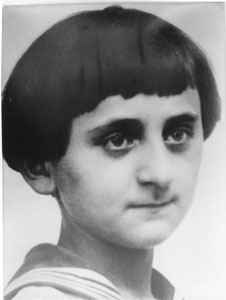
|
|
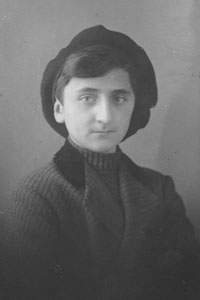
|
Frithjof Schuon around 1917
|
|
Frithjof Schuon around 1920
|
| |
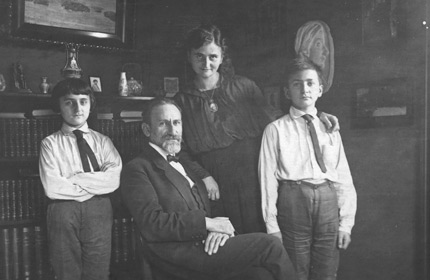
|
The young Frithjof Schuon (far left) with his father, mother, and older brother in Basel in 1917
|
| |
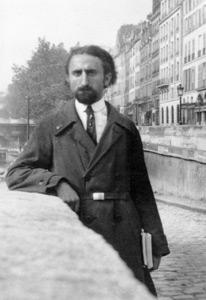
|
|
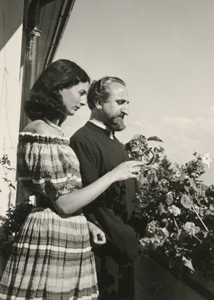
|
Frithjof Schuon in Paris around 1930
|
|
The Schuons in 1950 in Lausanne, Switzerland
|
| |
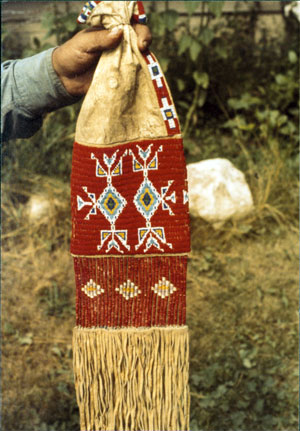
|
|
|
This is a photograph of Thomas Yellowtail holding a sacred pipe bag that originally belonged to Black Elk, the famous Sioux holy man. Black Elk gave the pipe bag to Joseph Brown in 1947, Brown gave it to Frithjof Schuon in 1949 and Schuon then gave it to Yellowtail in 1953. It remained one of Yellowtail’s most prized possessions until his death in 1993. Read footnote 15 on pages 16 and 17 in an interview in the online journal Vincit Omnia Veritas with Michael Fitzgerald, Yellowtail's adopted son, for more details on this story..
|
| |

|
|
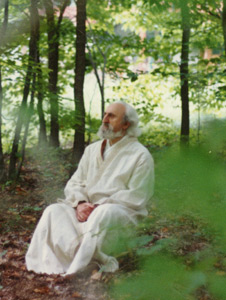
|
Frithjof Schuon in the Swiss Alps in the 1960s
|
|
Schuon in later years in the woods near his home in Bloomington, Indiana
|
| |
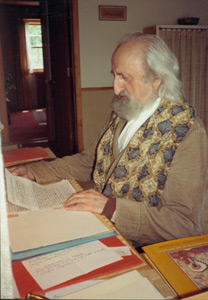
|
|
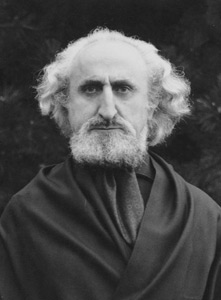
|
Schuon at his desk in his study at home in Bloomington, Indiana
|
|
Click on the button below to download a high-resolution version of this photo of Frithjof Schuon
|
|
|
|

|
|
 |
|
|

|
An essential link on the internet regarding the life and work of Frithjof Schuon is frithjof-schuon.com.
|

|
Scattered throughout the Sophia Perennis web site are numerous materials on Frithjof Schuon, including slideshows highlighting his artwork, excerpts from his books, some poems, and much more.
|

|
A good site for traditionalist/perennialist resources, including on Schuon, is religioperennis.org.
|
|
|
|
|
|
|